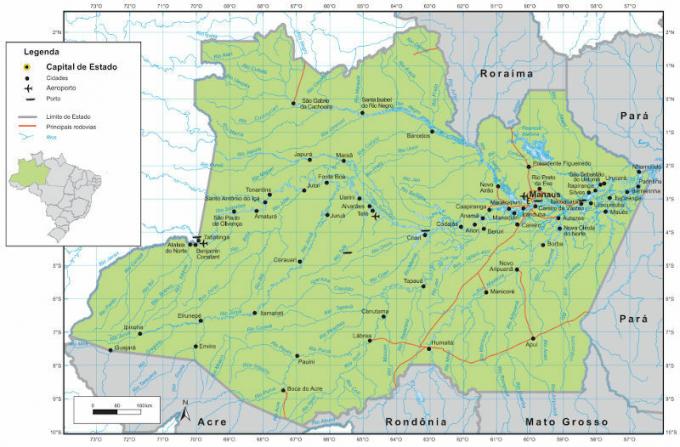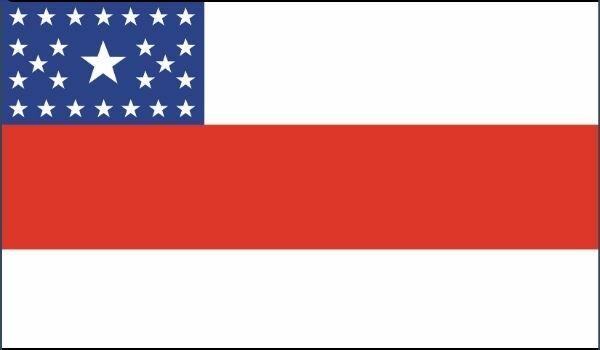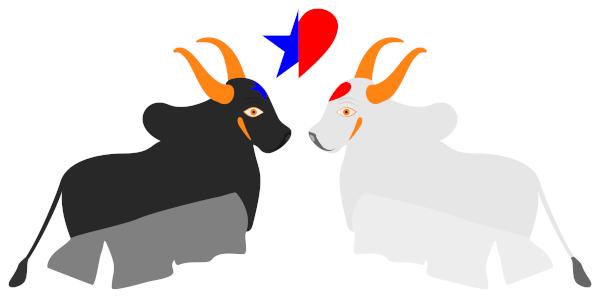O Amazons is a Brazilian state of North region, with capital in Manaus. And the largest unit of the federation in territorial extension. The Amazonian vegetation cover is formed by the Amazon Forest, which houses the greatest biodiversity in the world. The Amazon River, the largest on the planet and second longest, also flows through the state. It is in the state of Manaus Free Zone, an important industrial area in the country.
Read too: Regions of Brazil - groupings of states with similar characteristics
Amazon general data
- Region: North
- capital: Manaus
- Government: representative democracy
- Areaterritorial: 1,559,167,878 km² (IBGE, 2020)
- Population: 4,207,714 inhabitants (IBGE, 2020)
- Densitydemographic: 2.23 inhab./km² (IBGE, 2010)
-
spindle: Amazonas has two time zones:
- Amazon Standard Time (GMT -4 hours);
- Time in Acre (GMT -5 hours) in a small portion of western Amazonia, close to Acre.
- Climate: Wet Equatorial
Amazon geography
Amazonas is a Brazilian state that integrates the North region, with capital in Manaus
. With an area of 1,559,167,878 km², the Amazon territory is the largest in Brazil. A northern portion of the state lies in the Northern Hemisphere, being crossed, therefore, by the equator line.Five federative units border the Amazon, namely:
- Roraima, northeast;
- For, to the east;
- Mato Grosso, to the southeast;
- Rondônia, South;
- Acre, southwest.
The state's international borders are to the west, with Peru, and northwest, with Colombia and Venezuela.
Amazon climate
The predominant climate in the state is the Equatorial, characterized by high air humidity (80% on average) and high temperatures that last throughout the year. During the end of the autumn it's the Winter, there may be the occurrence of colds in the south of Amazonas, which corresponds to the drop in temperatures resulting from the advance of a cold front.
Rainfall rates registered for the state are the highest in the national territory, with averages between 1500 mm and 2500 mm per year, exceeding 3500 mm in some areas.
The most active climatic factors that define the conditions observed in Amazonas are the low latitude and continentality. The proximity of the dense forest also contributes to the control of local climate elements.
Amazon vegetation
The vegetation cover of the state is composed by Amazon rainforest. Within this formation, vegetation can be divided into three categories:
- Terra Firme forests, characterized by large species;
- Várzea forests, located in the floodplains;
- Igapó forests, in flooded areas.
Amazon Relief
The Amazon relief is composed of plateaus, depressions and plains, marked by the low and relatively flat lands that form most of the Amazon. With some exceptions, the altimetric dimensions of the state are between 0 and 300 meters.
According to Jurandyr Ross' classification, the Amazon can be divided into the following morphological units:
- North Amazon residual plateaus, in the northwest of the state and where its highest altitudes are concentrated. It is in this area, on the border with Venezuela, the highest point of Amazonas and Brazil: the peak of Neblina, with 2995.3 meters;
- Western Amazon Depression;
- Northern and Southern Amazonian marginal depressions;
- Plain of the Amazon River;
- Plateau of the Eastern Amazon.
See too: What are the types of relief?
Amazon hydrography
THE bowl HAmazon hydrographic, considered the largest in the world, covers, among others, the entire state of Amazonas. The main river that crosses the territory is the Amazons, the longest on the planet and the second longest after the Nile River. With source in Peru, the river arrives in Brazil with the name of Solimões. From its confluence with the Rio Negro, in the region of Manaus, it is named Amazonas.
Among the main tributaries of the Amazon that drain the state are the rivers Madeira, Purus, Juruá, Japurá and Içá.

Amazon map

Amazon Demographics
Amazon has 4,207,714 inhabitants, being the 13th state in terms of population in Brazil and the 2nd in the North region. In relative terms, the Amazonian population is equivalent to 22.5% of all inhabitants in the region. With a wide territorial surface, The demographic density of the state is one of the lowest in the country. The 2010 Census data show a value of only 2.23 inhab./km². Currently, this figure is 2.69 inhab./km².
With 79.09% urbanization rate, we have that the largest portion of Amazonians live in cities. The capital, Manaus, is the municipality with the largest number of inhabitants in the state and the 7th most populous in Brazil, with 2,219,580 inhabitants. Next is Parintins, with 115,363 inhabitants.
The last Demographic Census, dating from 2010, showed that Amazonas is the state with the largest indigenous population in Brazil, with 183,514 people. Amazonian indigenous people account for 20.46% of the Brazilian indigenous population, and 53.52% of the Northern region.

Geographical division of Amazonas
The Amazon territory is divided into immediate geographic regions and intermediate geographic regions, according to the IBGE. You 62 municipalities that make up the state are grouped into 11 immediate regions, which form four intermediate regions. Are they:
- Manaus, in the north and center;
- Tefé, in the west;
- Labrea, in the south;
- Parintins, in the east.
Amazon economy
The Gross Domestic Product (GDP) of Amazonas is R$ 100.1 billion, 1.4% of the national amount. The state represents the 16th economy among the federative units and the 2nd in the North region. The service sector and industry have a very close participation in the composition of the Amazon GDP, being, respectively, 38.53% and 34.30%. Agriculture represents 6.54% of the state GDP (IBGE, 2018).
The economic dynamism of Amazonas is led by activities of the industrial hub of Manaus, where its Free Trade Zone is located. There are installed national and international industries with great sectorial diversity, producing household appliances, computer products, transport equipment, motorcycles as well as industrial derivatives metallurgy.
At the primary sector, plant extractivism, fishing and the cultivation of grains such as corn, beans, rice, as well as fruits (orange, banana, pineapple, açaí) and vegetables stand out.
See too: What are agglomeration economies?
Amazonas Government
The government of the state of Amazonas is of the representative democratic type, with elections held at intervals of four years so that the population can choose its governors. The executive branch is led by the governor. The composition of the Legislative is made by three senators, eight federal deputies and 24 state deputies.
Amazon Flag

Amazon Infrastructure
The Amazon has extensive stretches of navigable rivers, which favored the installation of waterways in some of its main water courses. The Amazon River waterway is one of the most important river navigation routes on both a state and regional scale, especially for carrying out cargo transport. Also noteworthy are the waterways of the Madeira and Solimões rivers.
At BR-230 federal highways, known as the Transamazônica and that crosses the North and Northeast of Brazil in the East-West direction, and BR-319 they are among the roads that make up the state's road network. When it comes to air travel, Manaus International Airport is the main airport in the state and stands out for its capacity to transport passengers and goods.
Amazon culture
Amazon has a rich and diverse culture derived from the numerous traditions incorporated by the peoples that make up its population. These are indigenous peoples, Africans, Europeans, mainly Portuguese, and migrants from neighboring countries and other regions of Brazilian territory.
O Festival of Parintins takes place annually and is the main and most traditional party held in Amazonas, representing a great attraction for tourists from Brazil and the world. It is a celebration of Amazonian folklore that involves dances, songs and performances that revolve around the rivalry between the Bois-bumbás Guaranteed, represented by the color red, and capricious, represented by the color blue.

A series of festivals and festivals dedicated to music, cinema and Amazonian folklore in general are held throughout the state. Amazonian culture is also manifested in the craftsmanship, with the production of various pieces based on natural raw materials, such as seeds, fibers, leaves and feathers.
Many of typical dishes of the state include fish such as pacu, peacock bass, tambaqui and other fish in its composition, such as tacacá. Among the characteristic fruits of the Amazon, we have guaraná and açaí.
History of the Amazon
Before the arrival of the settlers, the area occupied today by the Amazon was inhabited by indigenous peoples. Like advance of Europeans by South America, the Brazilian territory was divided between Portuguese and Spanish by Treaty of Tordesillas, in 1494. In this sharing, the Amazon came under Spanish rule. The entry took place through the Amazon from 1500, and the exploration of Amazonian lands began in the middle of that century.
Over time, many disputes over the territory, until then not colonized by the Spaniards, were fought between these and other European peoples, especially the Portuguese. O Madrid Treaty, signed in 1750, marked the passage of Amazonian lands to the domain of Portugal, and, a century later, the province of Amazonas was created.
The end of the 19th century was marked by the cycle of Brubber, which represented the significant economic development of Amazonas, with major infrastructure works and an intense migratory flow to the region. The process of industrialization in the state and the resumption of economic dynamism took place in the mid-twentieth century, when the creation of the Manaus Free Trade Zone was consolidated.
By Paloma Guitarrara
Geography teacher
